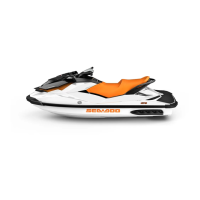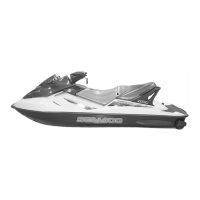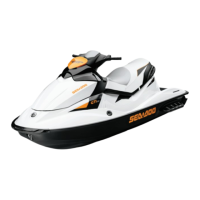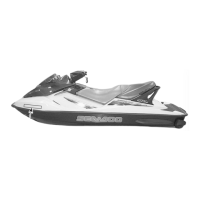SPECIAL SAFETY MESSAGES
Reminders Regarding Safe
Operation
The performance of this watercraft
may significantly exceed that of other
watercraft you may have operated.
Make sure you read and understand
the content of this Operator's Guide
to bec ome completely fam iliar with
the controls and operation of the wa-
tercraft before embarking on your first
trip, or taking on a passenger(s). If you
have not had the opportunity to do so,
practice driving solo in a suitable traf-
fic free area to be c ome accustomed
to the feel and response of each con-
trol. Be fu lly familiar with a ll co ntro ls
before accelerating above idle speed.
Do not assume that all PWCs handle
identically. Each model differs, often
substantially.
Always keep in mind that as the throt-
tle lever is returned to the idle position,
less directional control is available. To
turn the watercraf t, both steer i ng and
throttle a re necessary. Do not release
thrott le when trying to steer aw ay from
objects. Your need throttle to steer. If
the e ng in e is shut o ff, directio na l con-
trol is lost.
Although most watercraft have no
means of braking , advancem e nt in
technologie s now permit u s to offer
some models that are equipped with
a braking system called the iBR
TM
sys-
tem. Prac tice braking m aneuvers in
a safe traffic-f ree area to beco me fa-
miliar with handling unde r brakin g and
with stopping distances under various
operating conditions.
WARNING
Stopping distance will vary d
e-
pending on initial speed, load,
wind, number of riders and water
conditions. The amount
of braking
power commanded by the opera-
tor using the iBR lever (intelligent
Brake and Reverse) wi
ll also affect
stopping distance.
When braking, riders m ust brace them-
selves against the deceleration force
to prevent from moving forward on the
wate rcraft and losing balance.
When operating an iBR equipped wa-
tercraft, be aware that other boats fol-
lowing or operating in close proximity
may not be ab le to stop as quickly.
When at s peed and the brake is first
applied, a plume of w ater will shoot up
in the air behind the w atercraft which
may cause the operator of a following
watercraft to mo m e ntarily lo os e sight
of your PWC. It is important to inform
the operator of a watercraft who in-
tends to follow in a convoy formation,
of the braking and maneuvering capa-
bility o f you r PW C , w hat the plume o f
wate r indica tes, and that a gre ater dis-
tance should be maintained between
watercraft.
When actuating the iBR control lever
while the watercraft has some for-
ward speed, the braking mode will
engage and generate a deceleration
proportion al to the iBR lever position.
The more you pull in the iBR lever, the
greater the braking force becomes.
Be carefu l to gradually act uate the i B R
lever to adjust the intensity of the brak-
ing force, and to simultaneously re-
lease the throttle lever.
The brake feature of the iBR system
cannot prevent your PWC from drift-
ing due to current or wind. It has no
braking effect on the rearward motion.
Also note that your engine must be
runningtobeabletousethebrake.
The personal watercraft jet thrust can
cause injury. The jet pump m ay pick up
debris and throw it rearward causing a
risk of injuring people, damaging the jet
pump, or other property.
Observe the instructions on all safety
labels. They are there to help ass ure
that you have a safe and enjoyable out-
ing.
________
SAFETY INF
ORMATION
________
9

